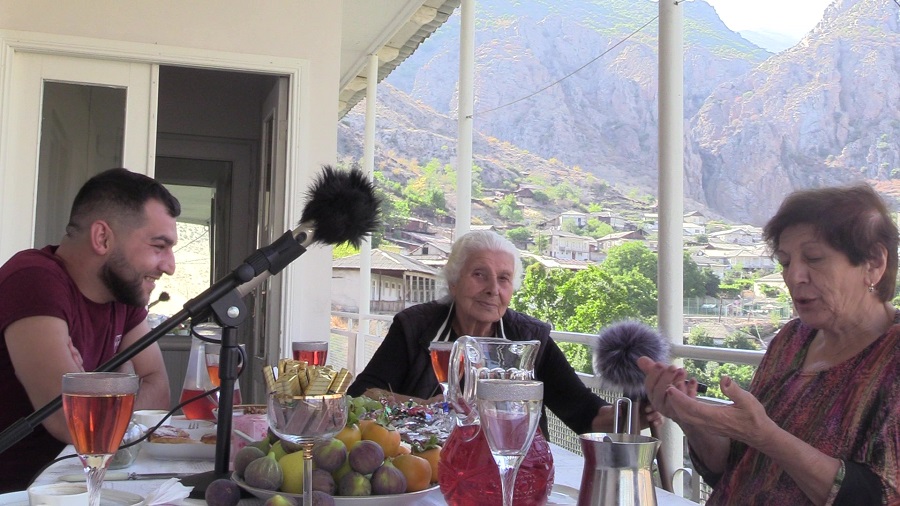A Documentation of the Zok Language (otherwise known as the Armenian dialect of Agulis)

A session with Volodya Jahangiryan, Yermonia Matevosyan and Meline Gevorgyan in Karchevan village, Armenia. Photo by Katherine Hodgson, 2021. Click on image to access the collection.
| Language | Zok (ISO639-3:) |
| Depositor | Katherine Hodgson |
| Affiliation | University of Cambridge |
| Location | Armenia |
| Collection ID | 0632 |
| Grant ID | IPF0300 |
| Funding Body | ELDP |
| Collection Status | Collection online |
| Landing Page Handle | http://hdl.handle.net/2196/a6066f5c-1961-4874-bd78-491c41de5f61 |
Summary of the collection
Language information
Group represented
Collection contents
Collection history
Special characteristics
Although some written texts exist in Zok (many of which are collected in Ayvazyan 2011), and grammars and glossaries (in Armenian) have been produced (Sargsiants 1883, Acharyan 1935, Zakaryan 2008), there is, to our knowledge, no publicly available audio or video material of spontaneous speech. This deposit fills that gap, providing information essential to many kinds of linguistic analysis, such as intonation, which is crucial to understanding the workings of information structure, and phonetic and phonological detail absent from or standardized (sometimes inaccurately) in written texts. In addition, it provides material on dialect variation within Zok that has not been systematically recorded. Sargsiants (1883) presents some examples of the differences between the dialects of Agulis and Tsghna, but this is very far from a complete description of Tsghna dialect, and he also implies that the dialect of Ramis is the same as that of Tsghna, which is not the case (although it shares some features that distinguish it from the Zok of Agulis itself). To our knowledge, apart from the material collected here, there is no information publicly available on the dialect of Ramis. Some field notes on vocabulary, phonology, and morphology were made in Soviet times by the H. Acharyan Language Institute of the Republic of Armenia, but these have apparently been lost, as have those on Tanakert and Tsghna. The same project recorded field notes on the dialect of Paraka, which exist, but have not been published. Ayvazyan (2011) contains a text supposedly in Paraka dialect, but judging by the field notes and the materials collected by this project, it does not accurately represent the dialect. This deposit contains extensive material in Paraka dialect. It allows a detailed comparison between the forms of the language spoken in Tanakert (very close to the dialect of Agulis itself), Tsghna, Ramis, and Paraka, thus illuminating the relationships between them, as well as the relationship between Zok and the related dialects of the Meghri area (Karchevan and Kuris).
In terms of salient linguistic features, the recordings in this deposit include narratives, descriptions, procedural discourse, and everyday conversation, as well as responses to the Pear Story video (Chafe 1980), allowing a detailed investigation of the unique tense and aspect system of Zok as it is used in natural discourse. It also allows an investigation of complex case forms (showing that they are not necessarily associated with animate referents, as Sargsiants (1883) suggests), and of word order and anaphora patterns linked to information structure: the use of postverbal arguments and of the pronoun inkʿə are topics of interest in this context, see Samvelian et al. (to appear), Donabédian-Demopoulos (2007). This deposit also contains responses to stimuli designed to elicit relative clauses, which provide new information on this topic (Hodgson 2019).
Other information
The standard (Hübschmann-Meillet) system for transliterating Armenian in the Latin alphabet is based on the pronunciation of Classical Armenian, and contains some symbols which are misleading in the light of modern pronunciation, so an adapted version has been used, and applied phonetically, with extra symbols for sounds not used in Classical or Standard Armenian:

ï = ɯ
ä = æ
ö = ø
ü = y
Cʿ = aspiration
Cʾ = palatalization
References
Acharyan, Hrachya. 1935. Kʿnnutʿyun Agulisi barbaŕi [An examination of the dialect of Agulis]. Yerevan: State publication.
Ayvazyan, Argam. 2011. Agulisi barbar’i masunk’ner. Yerevan: private publication.
Chafe, Wallace. 1980. (ed.), The Pear Stories: Cognitive, Cultural, and Linguistic Aspects of Narrative Production. Norwood, New Jersey: Ablex .
Chaudhury, Sushil & Kévonian, Kéram (eds). 2007. Les Arméniens dans le commerce asiatique au début de l’ère moderne. Paris: Éditions de la Maison des sciences de l’homme.
Dahl, Östen. 1985. Tense and Aspect Systems. Oxford/New York: Basil Blackwell.
Donabedian, Anaïd. 2007. A la recherche de la logophoricité en arménien. In Fernandez-Vest, J. Combat pour les langues du monde/Fighting for the World’s Languages, hommage à Claude Hagège. Editions L’Harmattan. 165-176.
Hodgson, Katherine. 2019. Relative clauses in colloquial Armenian: Syntax and typology. INALCO PhD thesis.
Jahukyan, Gevorg. 1972. Hay barbaŕagitakan neracutʿyun (vičakagrakan barbaŕagitutʿyun) [Introduction to Armenian dialectology (statistical dialectology)]. Yerevan: Republic of Armenia Academy of Sciences Press.
Samvelian, Pollet, Pegah Faghiri and Victoria Khurshudyan. 2023. On the persistence of SVO: The case of Modern Eastern Armenian. Linguistics 61(3). 459–497.
Sargsiants, Sargis. 1883. Agulecʿocʿ barbaŕə [The dialect of the people of Agulis]. Moscow.
Vaux, Bert. 2008. Zok: The Armenian Dialect of Agulis. In: Barlow Der Mugrdichian (ed.) Between Paris and Fresno. Armenian Studies in Honor of Dickran Kouymjian. (Armenian Studies Series 10). Costa Mesa, CA: Mazda Press, 283-301.
Zakaryan, Mari. 2008. Agulisi barbaŕi baŕaran [Agulis dialect dictionary]. Yerevan: Iravunkʿ.
Acknowledgment and citation
Users of any part of this collection should acknowledge Katherine Hodgson as the principal investigator, and the Endangered Languages Documentation Programme as the funder of this project. Users of parts of the corpus should acknowledge by name the people whose words and images are used (details in the metadata).
To refer to any data from the collection, please cite as follows:
Hodgson, Katherine. 2022. A Documentation of the Zok Language (otherwise known as the Armenian dialect of Agulis). Endangered Languages Archive. Handle: http://hdl.handle.net/2196/6a876738-cfc3-4c0e-9ef9-2f9c00e7ba27. Accessed on [insert date here].


